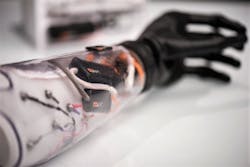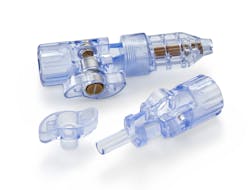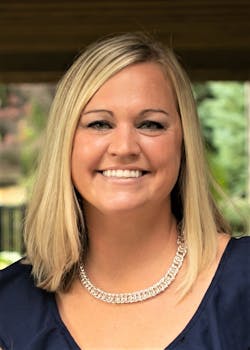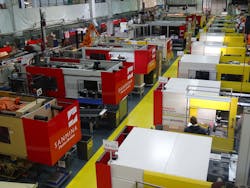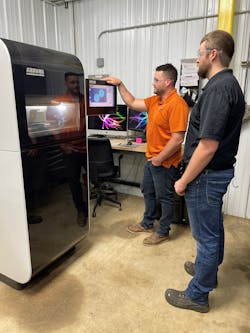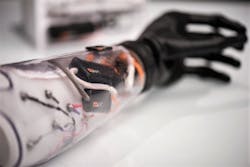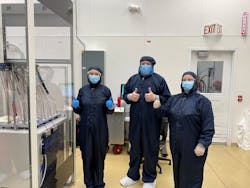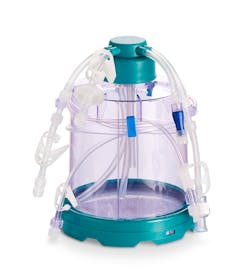Parts makers doctor their processes to meet medical needs
By Karen Hanna
The seal for a proposed testing kit couldn’t handle the chemical reagent or mechanical stresses required for doing its job: diagnosing infectious disease.
For the people at Minnesota Rubber & Plastics, who came up with a new seal geometry and material formulation, the project to produce a diagnostic kit is just one way COVID-19 has made its presence known. Like makers of plastic medical parts around the country, they’ve been busy.
While the pandemic forced much of the world to shut down, makers of plastic medical parts, including Minnesota Rubber & Plastics, have carried on. Often in the face of unprecedented logistical challenges, they have produced components of testing kits, ventilators and personal protective equipment, along with other supplies, that support patients battling for life. The products embody the precision, urgency and dedication to detail and safety that define the industry.
“Plastics is the intersection of innovation and health care and cost-effectiveness,” said Perc Pineda, chief economist for the Plastics Industry Association, who calls it “the glue that keeps costs and innovation going in the health-care sector.”
Processors involved in the market stressed both the innovation and urgency required over the past year. A number of processors say their experiences have them looking to expand further into the sector.
Demand surges in pandemic
“COVID first resulted in a lot of inquiries and working closely with non-medical manufacturers to help them understand the demands and requirements of medical-device manufacturing, such as biocompatibility,” said Krissy Dempsey, medical marketing manager for the life sciences unit of Saint-Gobain, part of the High Performance Solutions division of the plastics heavyweight. In 2019, that division logged about $9.2 billion in net sales.
While Dempsey said Saint-Gobain is positioned to absorb and overcome supply-chain disruptions, such as difficulties in sourcing resin, other companies acknowledged the last year has brought challenges — as well as opportunities.
“During the first phase of the pandemic, there was a spike in demand for plastics in products like COVID test kits, ventilators and face shields,” said Scott Schoenborn, GM of Sanmina’s Turtle Lake, Wis., facility, home to 75 presses with clamping forces ranging from 28 tons to 1,000 tons.
While production of COVID-related products has stabilized at the plant, parts and devices for non-COVID conditions are back in focus.
“We are seeing increased demand in particular for high-volume disposable products related to Type 2 diabetes, like insulin pumps and devices that monitor blood-sugar levels. The industry has also been developing plastic parts for products used in pacemakers, respirators, surgical instruments and medical consoles,” Schoenborn said.
For Saint-Gobain, which has 19 manufacturing sites worldwide operating in support of its medical components team, mask production also initially took precedence. Dempsey said the company quickly ramped up production across three continents. In addition, Saint-Gobain was responsible for producing infusion-therapy products, such as precision pump tubing, as well as filters and tubing used in respiratory therapies and machines, including ventilators, respirators and extracorporeal membrane oxygenation — a heart-lung bypass technology.
The company’s capabilities include silicone molding, thermoplastic molding, two-shot molding, silicone micromolding, custom filtration, manufacture of specialty closures, extrusion of silicone, thermoplastics, fluoropolymers, and catheter systems and assemblies, Dempsey said.
Demand remains high, Dempsey said.
At Turtle Lake, 350 people work in a 100,000-square-foot facility on behalf of a company with a varied portfolio, including a 20 percent segment devoted to medical products. Though not a new sector for Sanmina, the health-care segment — along with the difficulties posed by the pandemic — brought its share of challenges.
“Two years ago, we never would have considered that a pandemic could have the effects that it did,” Schoenborn said. “You really have to embrace your business continuity plan as it’s been quite effective during this challenging time. I would also emphasize that remaining flexible and always providing service to our customers without impacting quality is also critical.”
He summarized the lessons of the last year with a simple truism: “Expect the unexpected.”
Developing a body of work
PDS Plastics is a small molder in Michigan that has specialized in low volumes, and built a business portfolio making office furniture, auto parts and a variety of consumer goods.
“If you look at the trend in anything within medical, it’s not cyclical, like automotive,” said Zack Demaray, head of operations. “If you look over the last 20 years, it just constantly is climbing. If you look at it on a curve, it’s constantly going up, and it’s always there. Whereas automotive … you get those highs and lows on that curve, the ups and downs in the market. And you don’t get that in the medical field; it’s just constantly growing and increasing, so, that’s kind of why we’ve started to venture down that path.”
The purchase of an Arburg Freeformer catalyzed the company’s interest in the medical industry, allowing it recently to churn out some sample synthetic cartilage-type implants used in knee replacements.
The prototypes didn’t score a bigger project, but PDS Plastics is looking ahead.
Established in 1995 by Demaray’s father, the company recently purchased a second building, along with presses, from a defunct molder in Hamilton, Mich., about 20 minutes’ drive from the company’s headquarters in Dorr, Mich. The goal is to consolidate the two operations into one facility, where PDS Plastics can continue its venture into medical molding, as well as other opportunities.
“We’re trying to reach out to new markets and new customers all the time. And we have started ramping up into a couple of injection molding programs, medical customers, stuff that’s not a Tier 1 clean room,” Demaray said.
Like Demaray, John Nanry sees 3-D printing as a complement to traditional manufacturing, especially when it comes to low volumes, prototypes and customized parts. The co-founder and chief manufacturing officer of Fast Radius, which employs about 230 people, said his company provides access to machining and design services, as well as injection molding through a partner. It uses an array of additive-manufacturing technologies, including Carbon Digital Light Synthesis, HP Multi Jet Fusion (MJF) and Stratasys fused deposition modeling printers.
Medical parts have included prosthetics and anatomical models.
As Nanry describes it, Fast Radius specializes in parts in the size range of a softball to a cantaloupe. Split between two Midwestern manufacturing facilities, it has no clean room.
While Nanry said Fast Radius is dedicated to all its customers, the experience of working in health care is unique.
“Medical customers, it’s just another order of magnitude in terms of patient safety and showing that you have the controls around manufacturing a part,” he said.
Bringing medical parts into focus
At nearly 90 years old, Canon Virginia Inc. (CVI) is well-established, but it, too, still is growing into health care, having officially entered the market at the Medical Design and Manufacturing Event (MD&M West) in 2017 — the same year Fast Radius began as a company. It is constantly evaluating expansion in its health-care operations as it adds more business.
“I’d say in the last year and a half, we quadrupled the number of people that we’ve had over in the medical area,” said Rhonda Bunn, senior director of human resources and corporate communications.
The company dedicates 30,000 square feet of floor space and five presses, ranging in clamping-force capacity from 30 tons to 350 tons, to contract manufacturing of Class I and Class II medical devices. With a mobile clean room at its disposal, it offers contract scientific molding services from design through testing, packaging and logistics.
According to Wayne Daniel, CVI director of business development, it has a special emphasis on microfluidics — the use of fluids flowing through nano-sized channels to generate controlled chemical reactions in products such as low-cost diagnostic tests.
“With Canon and the microfluidic side, we’ve actually been doing that for years, because, with our inkjet printing technology, that is essentially microfluidics, where we’re moving microdroplets of printer ink in this case to paper,” Daniel said. “So, having that level of control is something that has given us this experience over the years and allowed us to expand outside of the inkjet printer market into medical devices.”
Bunn cited a project in which the company partnered with a medical-parts maker on an ophthalmology innovation.
In addition to the blinq vision scanning technology, which Canon and its partner, Rebion, introduced in January, the two companies now also are collaborating on Rebion’s Head & Intraocular Trauma Tool (HITT), which leverages a proprietary technique known as Neural Performance Scanning, to identify brain impairments related to traumatic brain injury.
“Canon Virginia is looking for collaborations with innovative, inspiring and determined medical device companies within the industry; we found this with Rebion,” CVI President and CEO Toru Nishizawa said. “We believe they have worked tirelessly to address amblyopia in children and continue the development of medical products in areas that may have a lasting impact for us all.”
Often, success is measured in features too small to be seen, Daniel said.
“So, microfluidics, there’s not a whole lot of companies out there that that get into that because of the complexity involved and the high precision involved, and that’s one of the areas that that we target because we have some unique technologies to help support that on the Canon side,” he said.
It starts with design.
According to Daniel, CVI works with clients to analyze part moldability and troubleshoot issues such as shrinkage, using scientific molding principles.
“Being able to build a robust process window around that tooling to accommodate the different variations and shrink is key,” he said.
Using proprietary technologies, CVI toolmakers can achieve a PV value of 30 nanometers — that’s the distance between a peak and a valley on a flat surface.
“And that’s what gives you your defined surface, your mirror-finish surface, that’s actually so precision that if you were to even touch it with your hand, you could mar that surface or breathe on it with your breath, that surface can oxidize quickly. There’s no way to fix it other than re-machining it,” Daniel said.
The rule for such tools: Hands off.
“We’re talking about machining to a level that if you were to try to improve it by hand-polishing, you would actually destroy the surface,” he said.
To better control the molding process, CVI offers its clients cavity pressure sensors, Daniel said.
Ensuring the quality of features that can’t be seen is a challenge for many medical molders.
It’s one CVI is comfortable confronting.
“If you can create something that has a nanometer-level of tolerances, then you also have to be able to measure those, and you have to be able to monitor those. ... And those are types of things that take a considerable amount of skill and expertise,” Daniel said.
In addition to mastering tight tolerances, CVI tackles a range of resins, including engineering resins. For its microfluidic parts, it uses an array — acrylic, polymethyl methacrylate and PC.
“Also, we’re looking at some of the ultra-high-UV-transmission materials for clarity and being able to use precision optics,” Daniel said.
Now in command of a sliver of the health-care market amounting to about 7 percent of its total business activity, CVI is looking for more — the goal in the next 3 to 5 years is 15 percent, company officials said. With its deep expertise in optical technology, including cameras and copy machines, the company is taking its best shot.
Clearing logistical hurdles
For companies in the health-care sector, the last year has brought both opportunities and challenges. Many ramped up operations to fill the need for products such as personal-protective equipment (PPE).
Like Saint-Gobain, other companies rushed to meet the need for medical parts. For example, CVI used in-house additive-manufacturing technologies to make mask parts for distribution in the area around its Virginia facilities during the early days of the pandemic.
The technologies give their users the ability to react quickly to new conditions, observed Fast Radius’ Nanry.
“When we move, we can move really fast,” he said.
In the past, Fast Radius’ medical parts have included prosthetics and medical models. Over the last year, its portfolio grew.
“We ramped up and did ventilator components and face shields as well as other PPE,” Nanry said.
Supply-chain disruptions continue to cause some challenges, the companies reported.
Dempsey said lead times have been getting longer, but Saint-Gobain has had few problems.
“There have been some market developments that may point towards the potential for further extended lead times and/or difficulty acquiring materials. However, Saint-Gobain is well-positioned to overcome such issues through supply agreements, dual sourcing and other mitigation efforts,” she said.
Representatives at both Sanmina and CVI acknowledged there have been issues — sourcing PC has been especially tricky.
For Sanmina, though, the situation might have a bright side.
“I think some of our customers have come to us as a result of some of their challenges, but I think for our materials, we have not hit any shortages yet,” Schoenborn said.
He and CVI’s Daniel said their companies were working with customers to plan resin usage.
“We are focused on improved planning and are continuing to communicate closely with our customers. We are also optimizing the resin we do have by reducing scrap. In some cases, we offer our customers an alternative raw-materials manufacturer, if it’s an option,” Schoenborn said.
In addition, Sanmina is working with suppliers to make contingency plans in case shortages occur.
“But we have not faced anything directly,” Schoenborn said.
CVI also has been able to make alternative arrangements.
“We are able to dual-source with different resin suppliers and be able to use similar, but different, materials on a product, so that’s one of the areas that we’re looking at now, upfront possibly approving different materials on a product, so that you can dual-source to get around some of those supply-chain constraints,” Daniel said.
Some projects can use small amounts of similar materials, as long as they have the same flow rates and shrinkage characteristics, Daniel said.
“Everyone in the supply chain is making an extraordinary effort to mitigate the issue and maintain levels of resins without affecting deliveries,” said Schoenborn, who blamed the shortages on petroleum production slowdowns created by a reduction in demand for fuel.
Lessons from a pandemic year
With facilities around the world, including China, France and Mexico, Minnesota Rubber & Plastics has persevered. Like other representatives of other processors, Spilseth said the company has not lost its focus — in the midst of the pandemic, it’s adding a clean room.
“Our priority is to assure continuity of supply by working really closely with our customers to support their requirements with alternative sourcing locations, different colors or alternative materials when necessary,” he said. “Our customers have been great to partner with to solve challenges presented by these economic conditions together.”
“We’re adapting and finding creative solutions to enable additional capacities in areas of unprecedented growth,” Saint-Gobain's Dempsey said. “We’re motivated to work quickly and efficiently to provide critical products and solutions that help save lives.”
She said her company, like others, had learned to adapt.
“Through it all, we’ve learned how to be a better team,” she said.
Sanmina’s Schoenborn stressed the importance of flexibility — and sanitation.
“We all had to learn how to keep operations running effectively without physically having everyone on site and can now use this approach where it makes sense. At the same time, we will continue staying updated on technology, automation and newer equipment,” he said.
While companies look to grow, they’re also keeping their focus on patients.
“We want to grow the business. I think the need is there to grow the business, whether it’s Canon or someone else, but definitely, currently, we’re still in the pandemic and there’s still a need and then there’s going to be post-pandemic [the question], ‘How do we not have the same thing happen again?’ ” Wayne said. “So, there will be growth.”
At Fast Radius, like other plastics processors, the company took pride in being able to play a direct role in health care during a pandemic. For employees, the experience was energizing, Nanry said.
“There is a much more direct focus on the patient … and not to say that the automotive and our other customers aren’t customer-focused for their customers, but, with medical devices, it’s kind of a very direct patient impact, and, so, there's actually a higher bar … of being very end-user-centric,” Nanry said. “These are devices that will likely interact with a person directly.”
Karen Hanna, senior staff reporter
More on medical parts and plastics
Health-care market keeps IMM makers busy
Injection unit, machine dedicated for test tubes among new processing technologies
Extruder OEMs respond to changing medical landscape
Auxiliary makers prioritized medical orders during pandemic
Robots shine in clean room duties
Economist: Run on medical goods provided jolt to plastics manufacturers
University speedily designs and prints nasal swabs
Geisinger’s 3-D lab printed devices to help health care workers stay safe
Beckwood Press designs compression molding equipment for medical devices
Quick deliveries, new products: Husky details COVID-19 response
About the Author
Karen Hanna
Senior Staff Reporter
Senior Staff Reporter Karen Hanna covers injection molding, molds and tooling, processors, workforce and other topics, and writes features including In Other Words and Problem Solved for Plastics Machinery & Manufacturing, Plastics Recycling and The Journal of Blow Molding. She has more than 15 years of experience in daily and magazine journalism.
